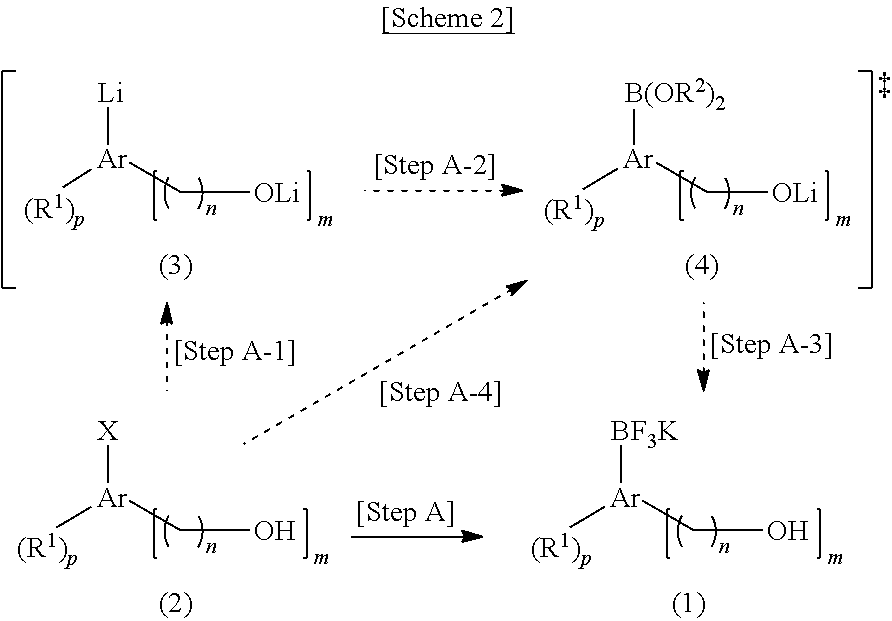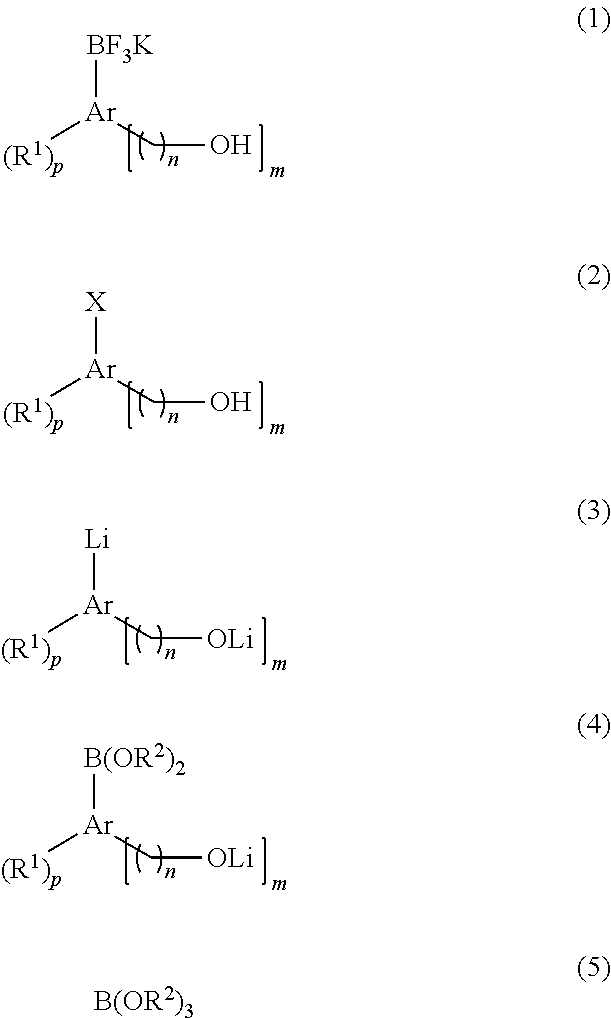Potassium Organotrifluoroborate Derivative and a Production Method Therefor
a potassium organotrifluoroborate and derivative technology, applied in the field of new potassium organotrifluoroborate compound, can solve the problems of side reactions, difficult quantitative reaction, and difficulty in recovering expensive ligands, and achieve the effect of convenient and economical
- Summary
- Abstract
- Description
- Claims
- Application Information
AI Technical Summary
Benefits of technology
Problems solved by technology
Method used
Image
Examples
example 1
Synthesis of Potassium 2-hydroxyphenyltrifluoroborate (3-Step Process)
[0048]
[0049]2-Iodophenol (220 mg, 1.0 mmol) was dissolved in anhydrous tetrahydrofuran (8 mL) under nitrogen atmosphere and kept at −78° C. After slowly adding tert-butyllithium (1.77 mL, 1.7 M pentane solution, 3 equivalents) dropwise for 10 minutes, reaction was further carried out at the same temperature for 30 minutes. After slowly adding triisopropylborate (188 mg, 1.0 mmol) dropwise for 15 minutes, the mixture was heated to −30° C. over 1 hour. After adding potassium hydrogen fluoride (273 mg, 3.5 mmol, 3.5 equivalents) and distilled water (4 mL) to terminate the reaction, the resulting mixture was vigorously stirred at room temperature. 30 minutes later, after completely removing the solvent using a vacuum distiller, moisture was completely removed under high vacuum. The residue was dissolved in anhydrous acetone (8 mL) and the undissolved salt was removed from acetone using celite. The filtered product was...
example 2
Synthesis of Potassium 2-hydroxyphenyltrifluoroborate (2-Step Process)
[0052]
[0053]2-Iodophenol (220 mg, 1.0 mmol) and triisopropylborate (188 mg, 1.0 mmol) were dissolved in anhydrous tetrahydrofuran (8 mL) under nitrogen atmosphere and kept at −78° C. After slowly adding tert-butyllithium (1.77 mL, 1.7 M pentane solution, 3 equivalents) dropwise for 10 minutes, reaction was further carried out at the same temperature for 40 minutes. Then, the mixture was slowly heated to −30° C. over 1 hour. After adding potassium hydrogen fluoride (273 mg, 3.5 mmol, 3.5 equivalents) and distilled water (4 mL) to terminate the reaction, the resulting mixture was vigorously stirred at room temperature. 30 minutes later, after completely removing the solvent using a vacuum distiller, moisture was completely removed under high vacuum. The residue was dissolved in anhydrous acetone (8 mL) and the undissolved salt was removed from acetone using celite. The filtered product was concentrated and then prec...
example 3
Synthesis of Potassium 3-hydroxyphenyltrifluoroborate (3-Step Process)
[0054]
[0055]Reaction was performed in the same manner as Example 1 except for using 3-iodophenol (220 mg, 1.0 mmol) instead of 2-iodophenol. Purification yielded the target compound (196 mg, yield=98%).
[0056]1H NMR (500 MHz, CD3OD) δ 7.04 (t, 1H, J=7.5 Hz), 6.98 (m, 2H), 6.61 (dd, 1H, J=7.5, 2.5 Hz).
[0057]13C NMR (126 MHz, CD3OD) δ 155.8, 127.9, 122.8, 117.9, 113.0.
PUM
| Property | Measurement | Unit |
|---|---|---|
| temperature | aaaaa | aaaaa |
| temperature | aaaaa | aaaaa |
| temperature | aaaaa | aaaaa |
Abstract
Description
Claims
Application Information
 Login to View More
Login to View More - R&D
- Intellectual Property
- Life Sciences
- Materials
- Tech Scout
- Unparalleled Data Quality
- Higher Quality Content
- 60% Fewer Hallucinations
Browse by: Latest US Patents, China's latest patents, Technical Efficacy Thesaurus, Application Domain, Technology Topic, Popular Technical Reports.
© 2025 PatSnap. All rights reserved.Legal|Privacy policy|Modern Slavery Act Transparency Statement|Sitemap|About US| Contact US: help@patsnap.com



